CHAPTER 1 — The History of Modeling
15 minute read
Prehistoric Models and the Cosmos
The first models attempted to create order out of the randomness that early hunter-gatherer humans must have felt in the relatively uncontrollable environment in which they lived. Among the most prevalent were models based on the pattern of celestial phenomena, from daily sunrise through monthly moon phases to the yearly return of seasons. The cycling stars, and our hard-wired proclivity to discover pattern, led to a system of charting that included constellations which survive to this day. Many of the texts associated with these ancient activities border on the mystical and must be read critically, but one can certainly find researchers working within the parameters of intellectual, un-sentimentalized rigor.
The Caves at Lascaux
|
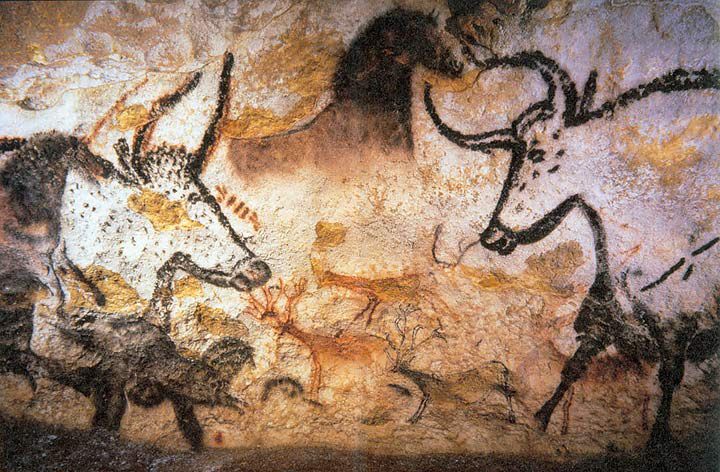
Figure 1.1 | The Great Hall of the Bulls in the Lascaux Cave complex.
|

Figure 1.2 | The auroch, a bull-like creature, drawn over the constellation Taurus.
|
Historically, scholars believed that celestial mapping and prediction was a habit of necessity formed out of the beginnings of agriculture, needed to foresee seasons of planting and harvest. However, independent archaeo-astronomer Chantal Jègues-Wolkiewiez has hypothesized that at least some chambers at the famous Neolithic cave painting complex in Lascaux, France (Figure 1.1), are actually prehistoric models of the sky (Figure 1.2), and her theory is described in the video at Figure 1.3. These hunter-gatherers had no pragmatic agricultural need for modeling celestial cycles. Instead, they conflate the random star patterns with animals in their environment, creating one of the earliest tangible instances of model-making: the first constellations.
Figure 1.3 | National Geographic, Stone Age Zodiac, 2009.
Stonehenge
Whether erected for agricultural, social or religious reasons, the full purpose for the monument at Stonehenge (Figure 1.4) may never be understood. At minimum, its function as a cosmic apparatus is clear, as the structure marks many astronomical phenomena, the most celebrated of which are the solstices. Particular slits between standing stones reveal several other significant celestial events as well, but not all slits function this way, and it can be demonstrated that a few simple markers would perform the same essential function. So why create the seemingly superfluous standing stones and multiple concentric rings comprised of stones and barrows?
At the very minimum, they create a special, and some would say sacred, territory. They may suggest more: a cosmological model referencing man’s place in the natural schema. The center reference point, from which so many celestial phenomena can be witnessed, suggests these humans regard themselves as occupying a central place within the cosmic order. The concentric circles, seen in Figure 1.5, can therefore be seen functioning both as a precise astronomical machine and as a metaphor, a model of our position within the cycles of nature and the cosmos.
The Great Pyramid at Giza
Constructed in the same era as Stonehenge, the Great Pyramid at Giza models many phenomena. A fairly explicit and well-documented one is the notable way the shape of the pyramid models the rays of a sun which was worshipped as a god (Figure 1.6). In his autobiography, English engineer and pyramid enthusiast James Naysmith recounts:
On many occasions, while beholding the sublime effects of the Sun’s Rays streaming down on the earth through openings in the clouds near the horizon, I have been forcibly impressed with the analogy they appear to suggest as to the form of the Pyramid… . I met with many examples of this in the Egyptian Collection at the Louvre at Paris; especially in small pyramids, which were probably the objects of household worship. In one case I found a small pyramid, on the upper part of which appeared the disc of the Sun, with pyramidal rays descending from it … .
Figure 1.6 | At left, Naysmith describes “a ‘rubbing’” from an Egyptian relief found in the Louvre depicting the adoration of the sun, formally compared with his own depiction of the rays of the sun at right.
Crepiscular rays of light are parallel, but the laws of linear perspective dictate they converge on the vanishing point of the sun. The bottom-heavy pyramid shape (seen in cross-section in Figure 1.7) is thus not merely a concession to gravity: it becomes an intuitive model of perspective projection, with a “false” vanishing point at its apex.
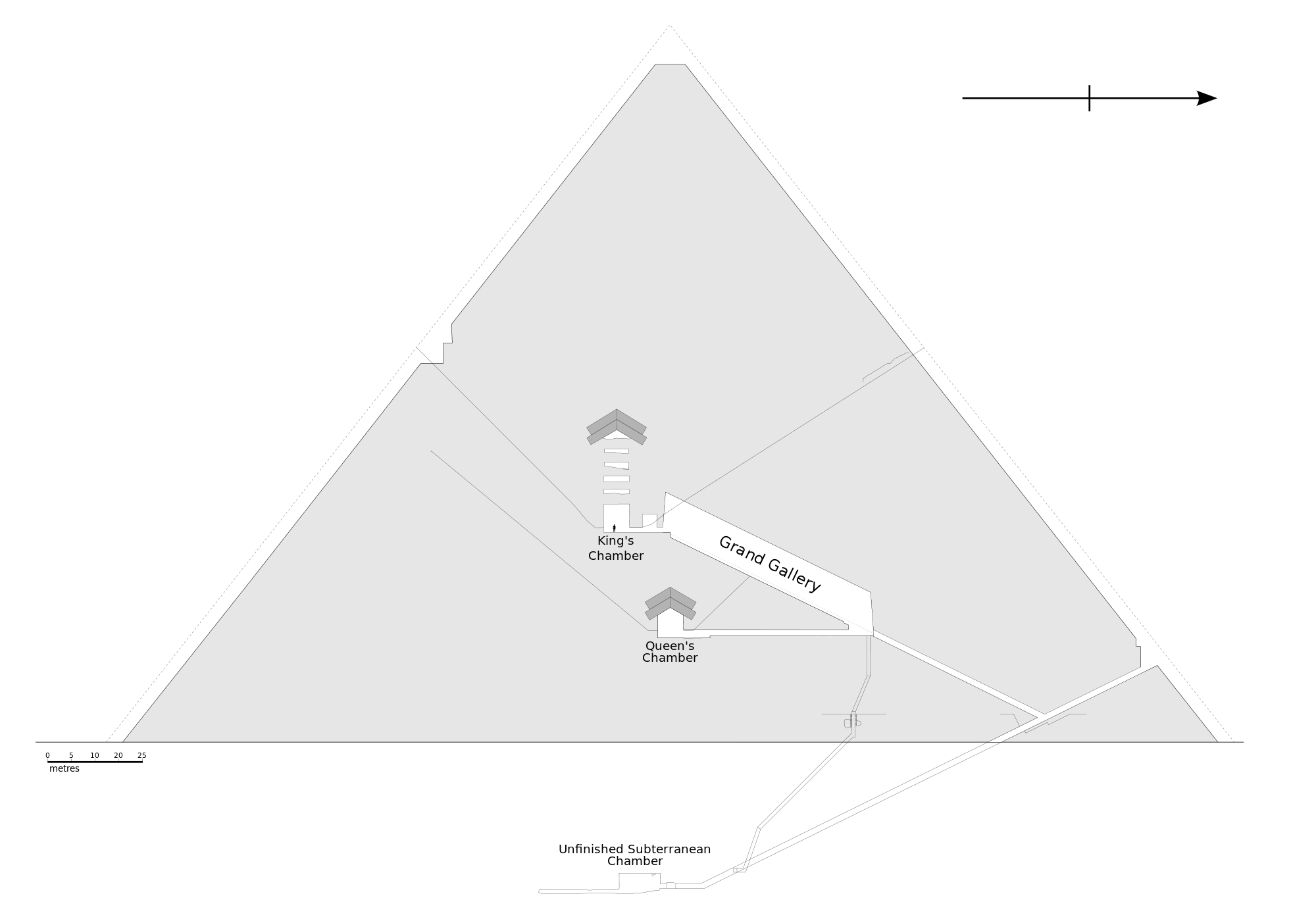 |
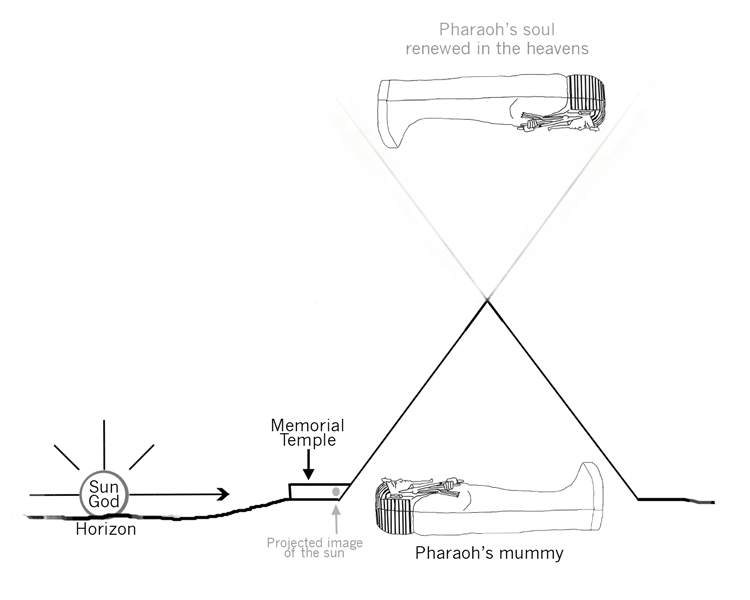 |
|
Figure 1.7 | A cross-section view of the Great Pyramid at Giza.
|
Figure 1.8 | Matt Gatton’s Paleo-Camera website contains seductively plausible iterations of the use of the camera-obscura phenomenon by many ancient civilizations. Here, the pyramid becomes a metaphorical soul projector.
|
Digging deeper, artist Matt Gatton has theorized a conceptual model of projection based on the camera-obscura phenomenon, whereby the mummy of the pharaoh is metaphorically elevated to renewal in the heavens. In his diagram at Figure 1.8, the pyramid metaphorically represents one cone of a camera-obscura projection that may have actually occurred in the memorial temple anteroom. The metaphorical projection is rotated 90 degrees to face the sky, where one projection is the stone of the pyramid and the other half is implied. Many theories concerning Giza, such as Robert Bauval’s pseudo-scientific mapping of the pyramid site plan onto the stars in Orion’s belt, have fallen into disrepute, but the general idea that some physical correlation between pyramids and astronomical phenomena remains plausible for an Egypt whose spiritual bent and societal structure would have supported such a monumental endeavor. Despite an attractiveness to mystics and crackpots, the pyramids without a doubt function as a model of the afterlife that so permeated Egyptian culture. To explore the Great Pyramid and the Giza necropolis, visit the NOVA website.
Speaking of the Afterlife…
Egypt’s afterlife was a parallel universe constructed out of projections of the details of earthbound daily life, both grand and mundane, into the everlasting hereafter. Spurning the idea that you can’t take it with you, royal and aristocratic tombs contained all the material wealth deemed necessary for a proper afterlife, including servants, animals and buildings. Eventually concluding it was a drastic use of resources to bury the real thing, detailed models were created, such as the one from an aristocratic tomb in Figure 1.9. These provide insight not only on the Egyptian view of the afterlife, but also on their earthly life.
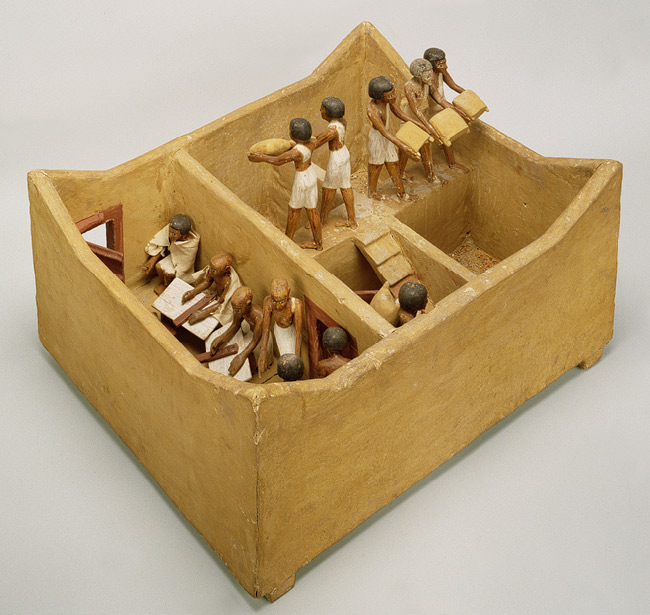 Figure 1.9 | Unknown artist, Scribes and a structure from Meketre’s model granary, Middle Kingdom, Figure 1.9 | Unknown artist, Scribes and a structure from Meketre’s model granary, Middle Kingdom,
c 1975 BCE. |
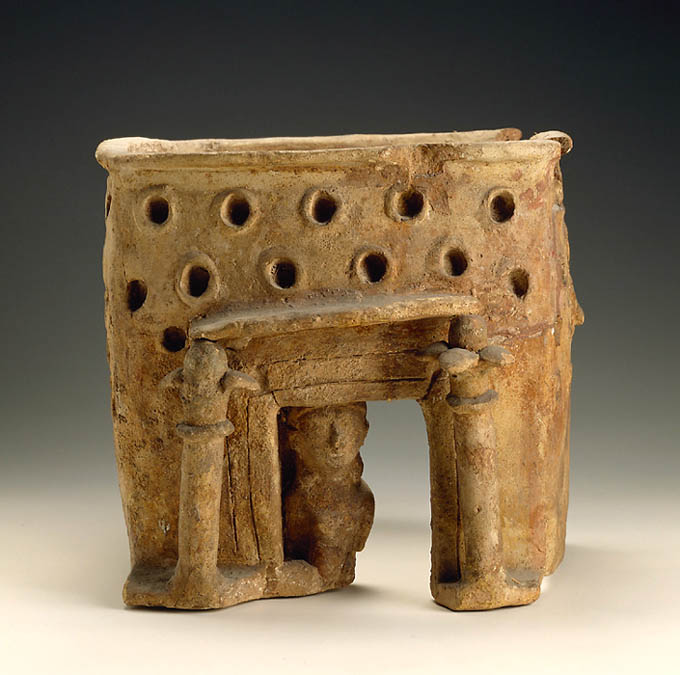 Figure 1.10 | Unknown artist, Model of a Shrine, Cyprus, 6th century BCE.
|
Architectural models were a staple feature of tomb adornment, not only in Egypt, but also throughout the Mediterranean basin. The model of a shrine in Figure 1.10 was found in a Cypriot tomb, and probably served a ritual function at burial, watching over the possessor’s soul as it made its final journey.
Aristocratic burial devices used a considerable amount of an ancient country’s gross national product. The most outrageous use of this brand of “you-can-take-it-with-you” modeling was discovered in the 1970s with the unearthing of the Terracotta Army in the tomb complex of the mytho-historical Chinese emperor Qin Shi Huang (Figure 1.11). The mausoleum is not completely excavated: legend has it that the central tomb chamber contains a model of Qin’s empire, complete with rivers made of mercury and a glowing rendition of the heavens inlaid in precious stones.
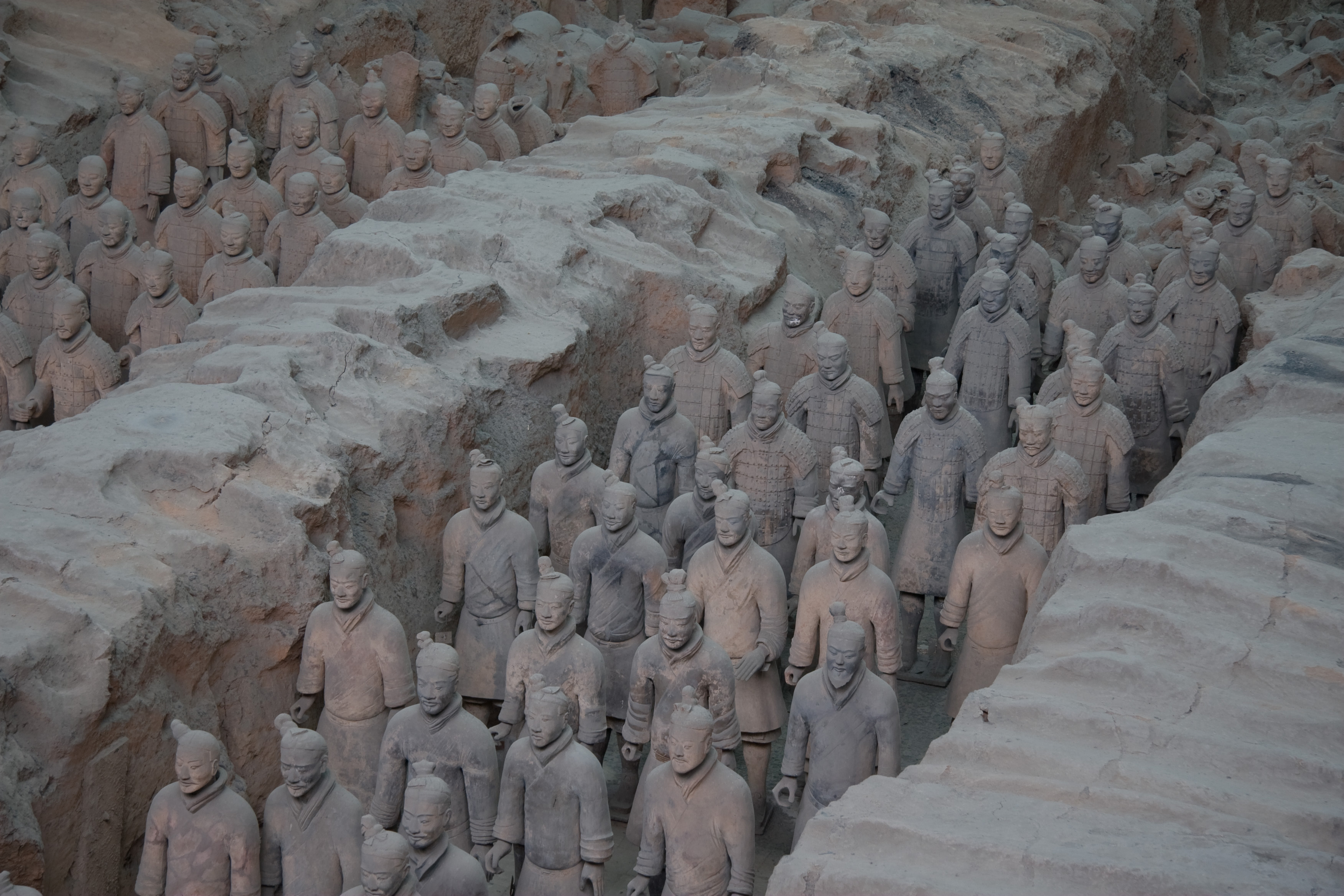 |
Figure 1.11 | Tomb of Qin Shi Huang,
Terracotta Army, circa 210 BCE.
|
Such tomb making fulfilled a spiritual purpose, but it also served a political agenda. As projections of political power, the tombs created in ancient people a cultish awe of their leaders, allowing royalty to maintain dynasties and bloodlines for centuries. Memorial building, modeling the power of the leader, became a staple of empire, from Egypt through Rome and beyond.
Renaissance and Enlightenment
Brunelleschi's Duomo
In 1292, Arnolfo di Cambio began one of the most important works of architecture in history. The Basilica di Santa Maria del Fiore, more commonly known as the Duomo of Florence in Italy, was a source of civic pride for the up-and-coming city-state. Florentines so approved of di Cambio's design that visual records of the day show the Duomo as a fait accompli (Figure 1.12), in spite of the fact that it called for a dome so large that no one knew how to build it. As the need for an answer to the inevitable question of the dome’s structure became more urgent, a competition was held at the dawn of the Renaissance, the early 1400s, to discover the builder who could find a way to complete the visionary design, which explicitly did not call for the use of Gothic buttresses.
|
Figure 1.12 below | Andrea di Bonaiuto, fresco detail featuring the Duomo, painted in the 1390s,
a generation before the dome was constructed.

|

Figure 1.13 above | Colorized postcard c 1900 featuring the Duomo in a dramatic view that has remained fairly unchanged from 1469 to today.
|
Competitors used large, detailed models to communicate their ideas for a structural design of the dome. Filippo Brunelleschi had by far the most innovative design: a double nested dome knit together with internal stiffening ribs and ringed with enormous stone and iron "chains" counteracting spreading forces like the iron hoops of a barrel. Brunelleschi, who wanted to maintain control of the politically volatile project, intentionally left the winning model incomplete (Figure 1.14). A second competition was held for the lantern, the small structure atop the dome, and again Brunelleschi used a model to win (Figure 1.15). Structural engineering science would not be developed until centuries later, so like other cathedral builders, Brunelleschi relied on intuition. His intuition was informed by high fidelity models that predicted structural remedies, and the modeling method was so successful the Duomo, the largest brick dome ever constructed, remains sound centuries later.
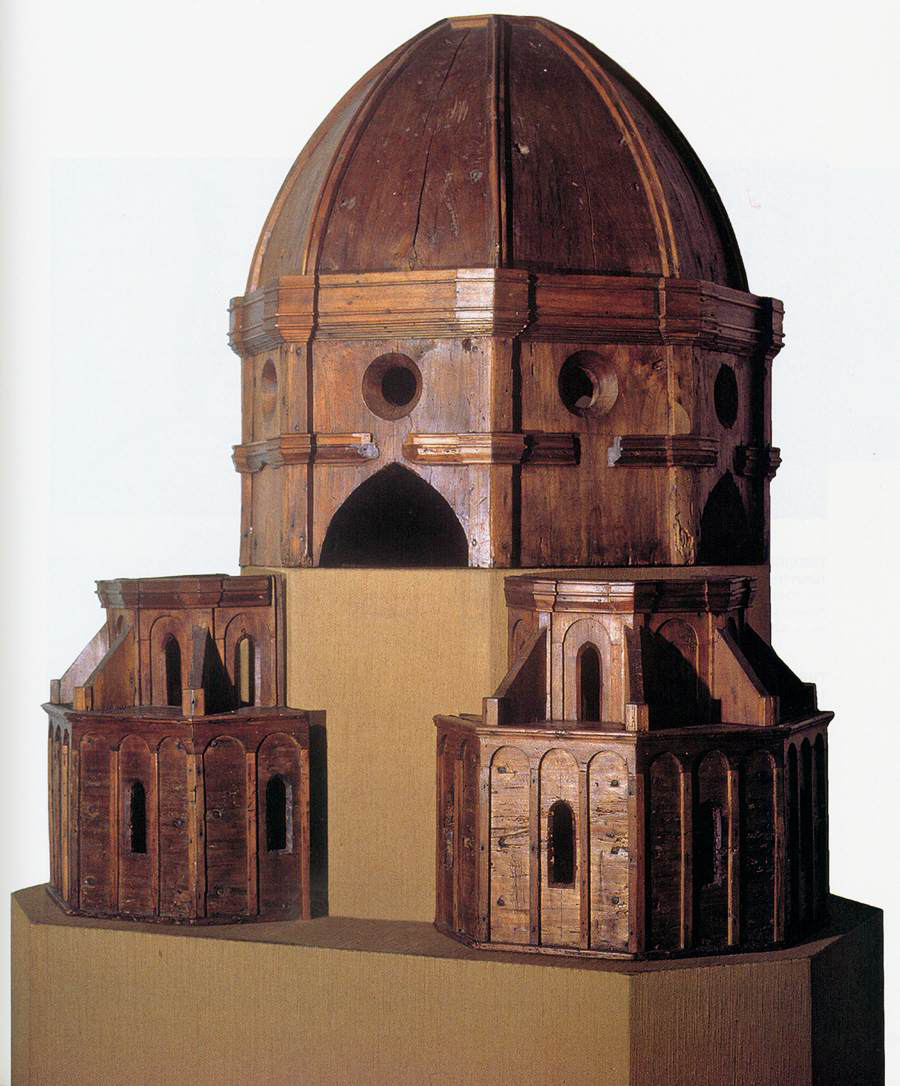 |
Figure 1.14 left |
Filippo Brunelleschi, Model
of the Dome, circa 1419.
Figure 1.15 right |
Brunelleschi’s model for the Cupola, circa 1440.
|
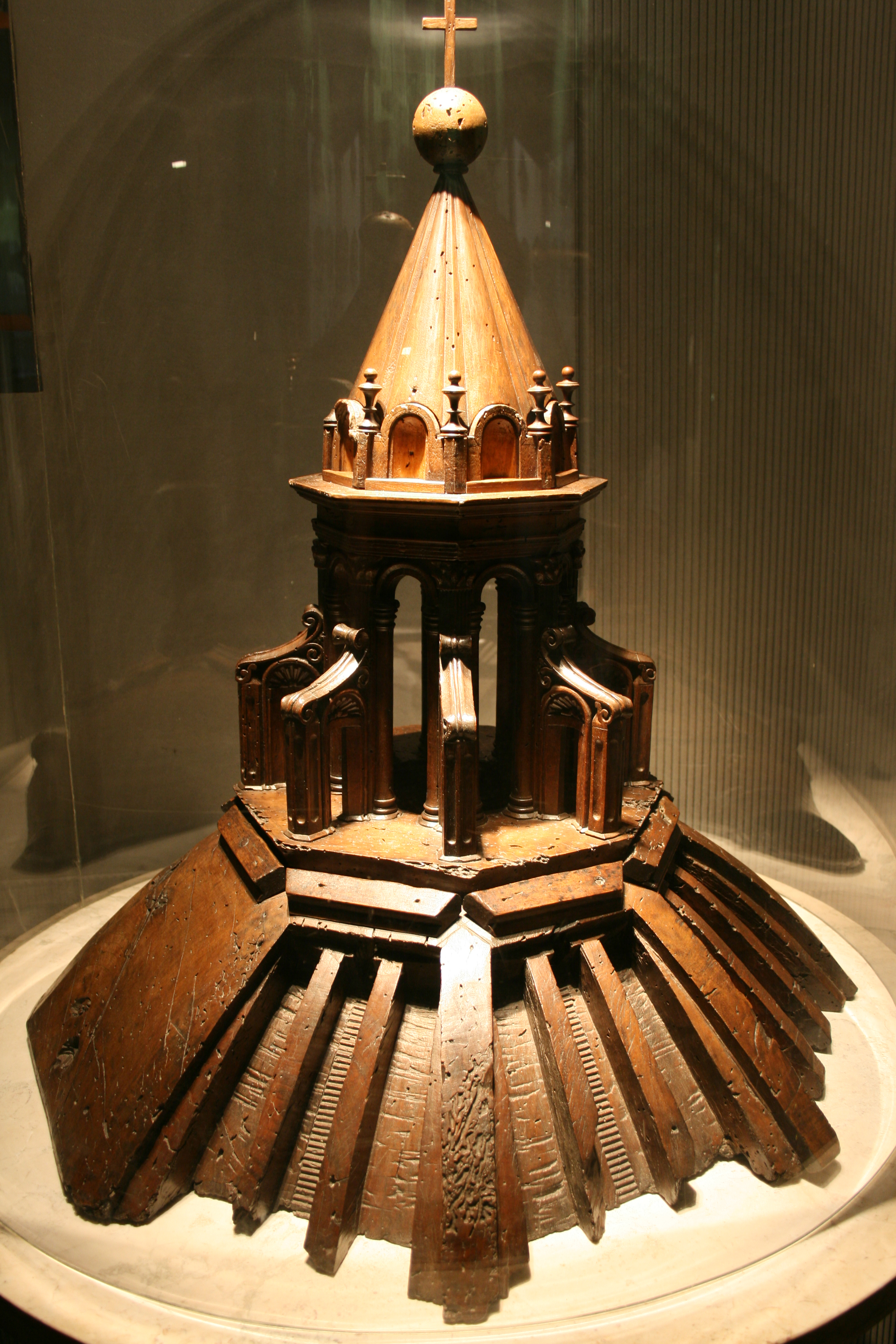 |
The Orrery
The Renaissance of the 14th—17th centuries CE ushered in a historically unprecedented era of respect for science and reason in the 18th century known as the Enlightenment. Models were used to create expressions of newfound scientific knowledge on many fronts. Although earlier ones exist in the historical record, the mechanical model of the solar system called the orrery became quite popular during this era (Figure 1.16).
In most orreries, positions are usually relative and not to scale, although some orreries achieve real time or true scale modeling. The Eisinga Planetarium in Franeker, the Netherlands, is not really a planetarium but a real-time, room-sized orrery, one of the largest in the world, run by a pendulum clockwork (Figure 1.17).
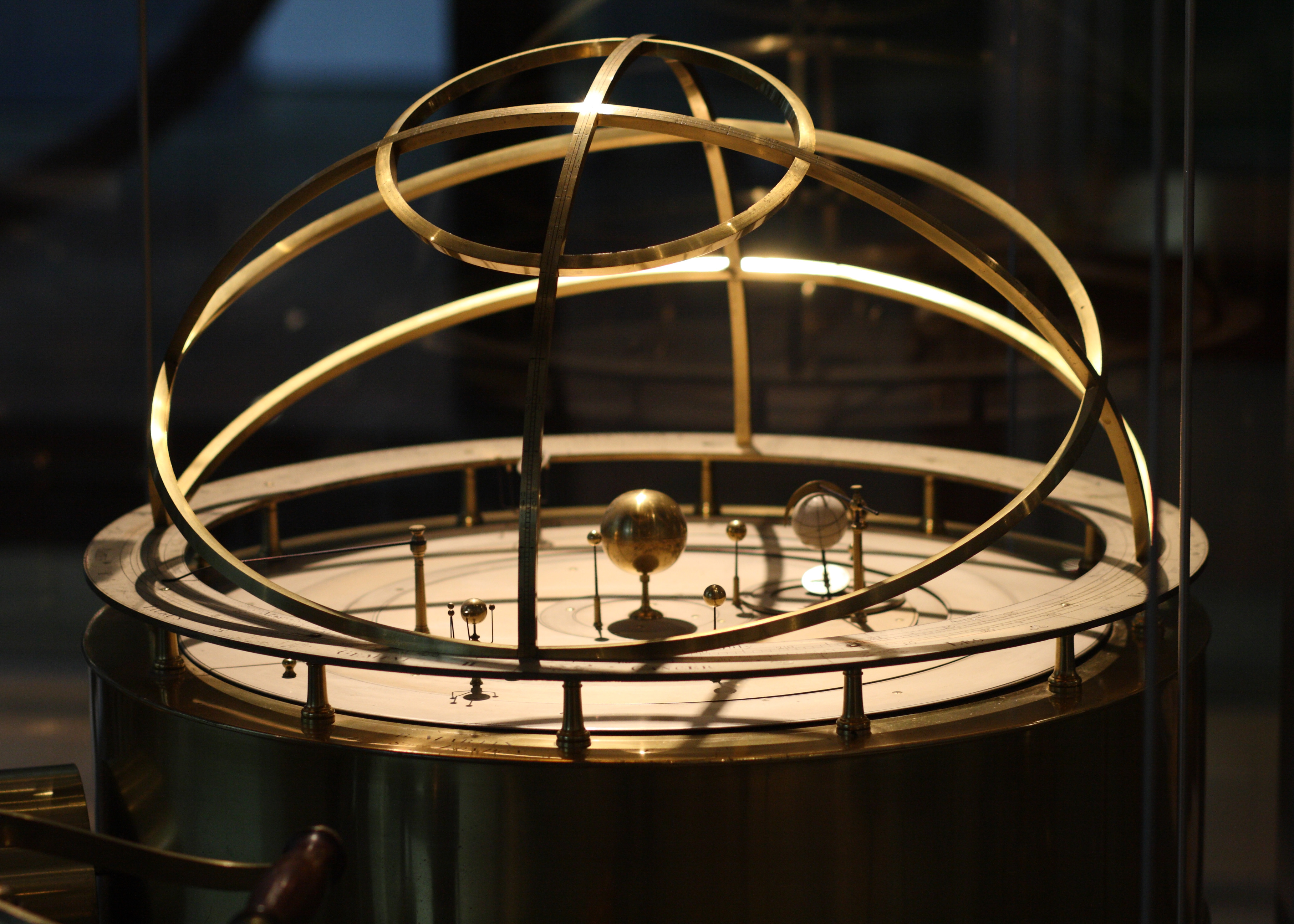 |
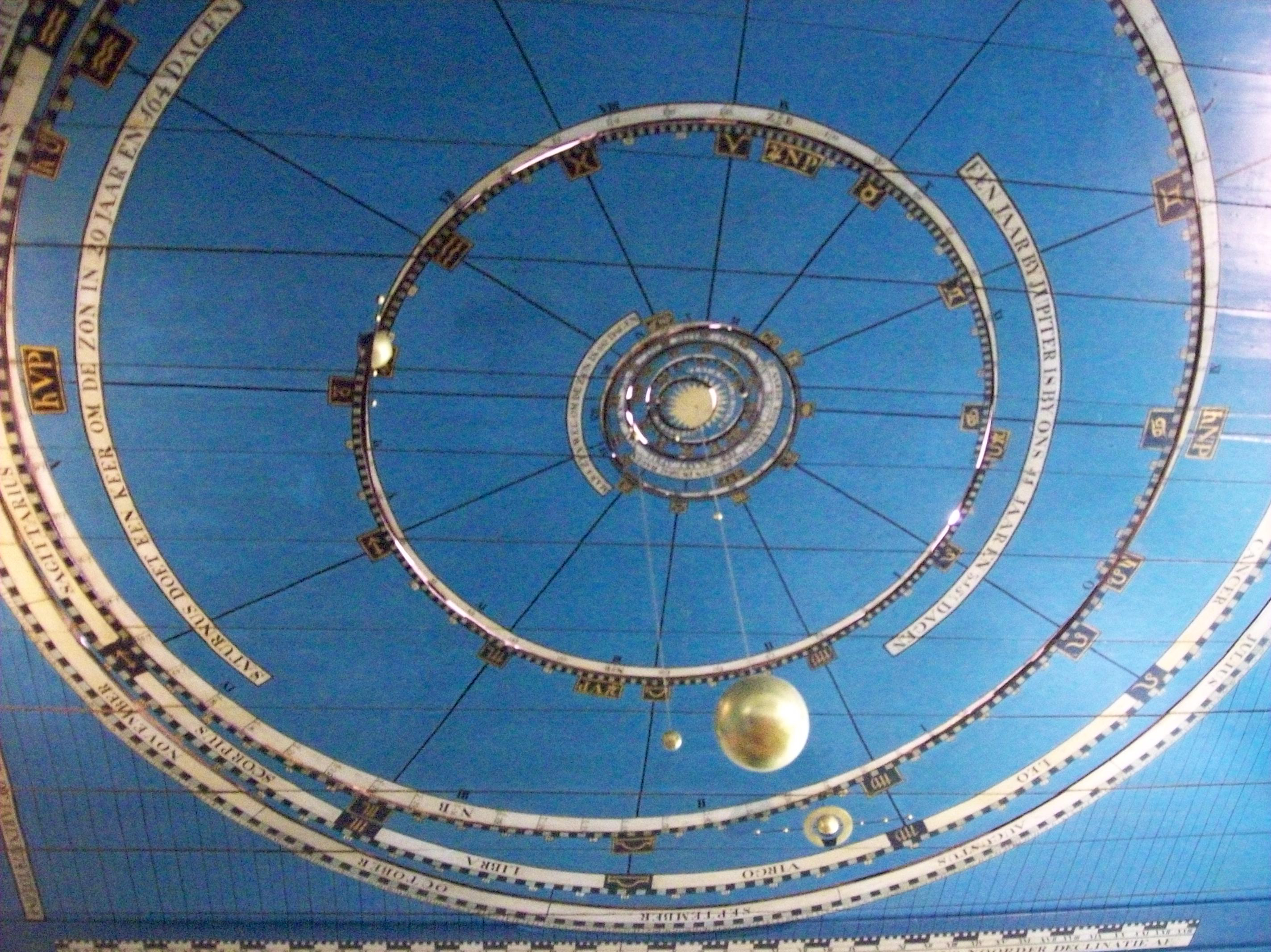 |
|
Figure 1.16 | A large orrery made by Benjamin Martin in London in 1767, on display at the Putnam Gallery in the Harvard Science Center.
|
Figure 1.17 | Interior ceiling of the Eisinga Planetarium, actually a large orrery.
|
Contemporary versions of the orrery include the 10,000 Year Clock at The Long Now Foundation. If you have Google Earth, user Barnabu’s add-ons include animated orreries. If not, there’s an interactive web-based orrery at Solar System Live by John Walker. His website has a bit of an old-school look, but if you tweak some parameters you can get interesting results.
Business and Pleasure
Before the advent of modern communication methods like photos or videos that could demonstrate the effectiveness of an invention, a patent seeker was required by the Patent Act of 1790 to submit a working model of an invention along with his or her application to the U.S. Patent Office.
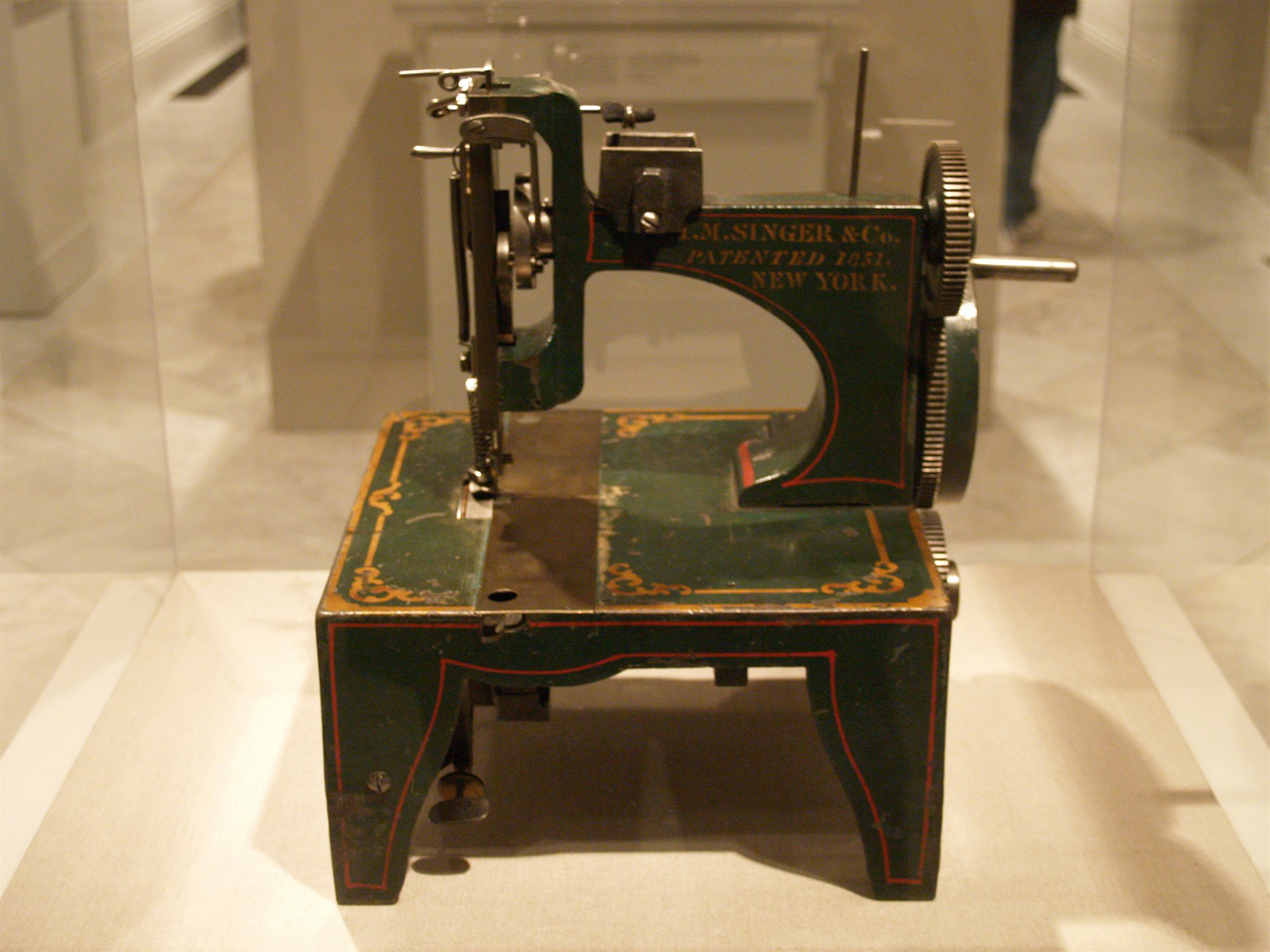 |
Figure 1.18 | Isaac Singer, Patent Model For Improvements To the Sewing Machine, 1854.
|
Almost a century later, the burden of keeping the models became overwhelming, the requirement was abolished, and the Patent Office liquidated its storehouse. While some patent models ended up at the Smithsonian Institution (Figure 1.18), the remainder landed in private hands, with the largest collection found at the Rothchild-Petersen Patent Model Museum. Professional model makers would create elaborate, well crafted, finely finished models out of expensive materials, the theory being that a fancy presentation would secure a patent (Figure 1.19).
Figure 1.19 | Rothschild Petersen Patent Model Museum on the History Channel at Vimeo .
The death of the patent model was not the death of modeling by any means, as modelers turned to the hobby market to ply their trade, creating objects ranging from finished die-cast metal vehicles to plastic put-together spacecraft. The 20th Century can be seen as a kind of Golden Age for hobby modeling. Models such as the famous Citroën toy cars (Figure 1.20) were marketing tools created by the manufacturer to introduce the idea of car-ownership to future drivers. Indeed, the pleasure of hobby modeling instills a sense of vicarious ownership: if you can't actually have the Millennium Falcon (Figure 1.21), you might fantasize you do when you finish the model.
|
Figure 1.20 below | Citroën car model from the 1960’s. Versions range from die-cast models made by Citroën to plastic, such as this one from Norev.

|
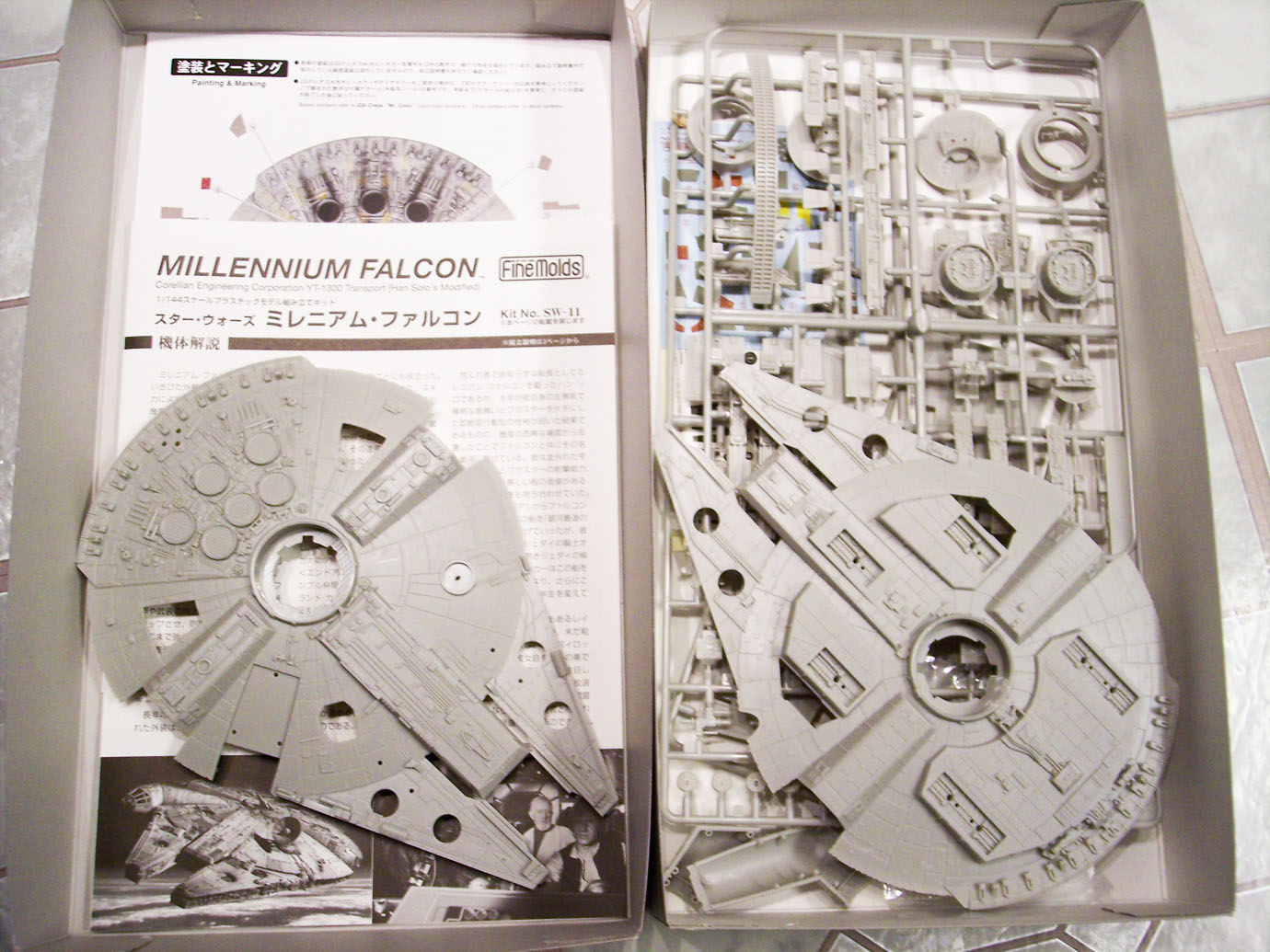
Figure 1.21 above | She may not look like much... but this FineMold PVC kit’s got it where it counts.
|
Enter Digital Modeling
Digital visualization was limited at first by the mechanical visualization modes that preceded it. At first, CAD (computer aided drafting) literally tried to emulate T-square and triangle drafting. Over time, programmers and users realized they had an entirely new way of looking and making. Because of the way the computer handles information, it became clear that so much more than a 2D drawing process could be emulated.
Among the transformative tools that evolved out of early CAD were 3D models that could be looked at from a variety of angles, making a bulky and expensive architectural model hard to justify, if not outright obsolete. 4D or time-based modeling evolved out of this, as objects and cameras could be modeled to change over a timeline, transforming not only design visualization but also entertainment. Entire industries, such as gaming and cinematic CGI (computer generated imagery), have developed out of this.
More recently, innovations in manufacturing and building at large scale have come to depend on 4D modeling. In shipbuilding and aircraft construction, information modeling is used to control part inventory and scheduling. In architecture, building information modeling (BIM) programs such as Revit use libraries of parts and animated workflow to manage a job site (Figure 1.22). In 2006, Boeing used animation and information modeling to present a "virtual rollout" of the 787 Dreamliner (Figure 1.23). This kind of modeling can reveal a design flaw, such as a bolt that can't be reached by a tool, before such an issue becomes a thorny and costly one.
|
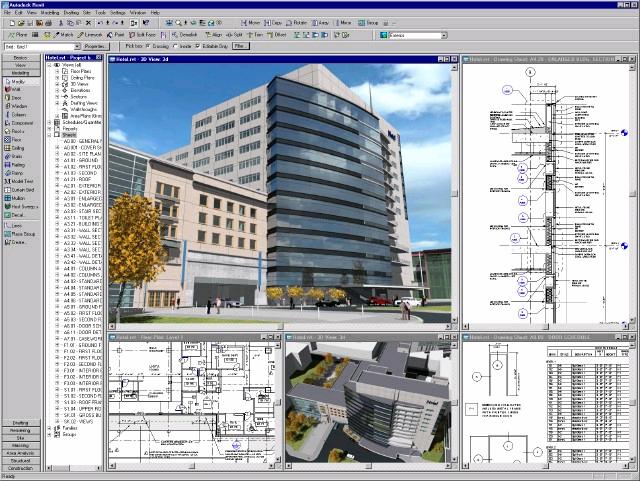
Figure 1.22 | Screen shot of Revit, a BIM (building information modeling) software from AutoDesk.
|

Figure 1.23 | Boeing’s 2006 virtual rollout of the 787 Dreamliner.
|
This concept of the virtual build processes (VBP) has allowed artists such as Richard Serra, Claes Oldenburg and Coosje Van Bruggen to create large-scale, geometrically complex work. Serra discusses the role of model making in his work at this link.
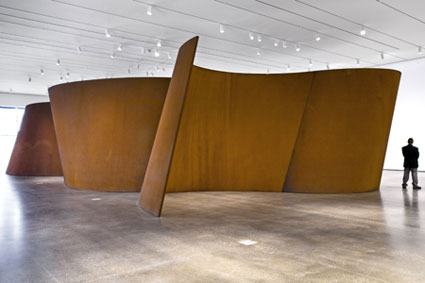 |
Figure 1.24 left | Richard Serra, Band, 2006.
Figure 1.26 below left |Digital rendering for Oldenburg and Van Bruggen's Collar and Bow, projected for completion in 2004. Models could not predict the technical difficulties of its installation.
Figure 1.25 below right | Oldenburg and Van Bruggen's bow tie lies in storage in 2008 while lawsuits abound...
|
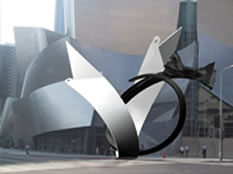
|
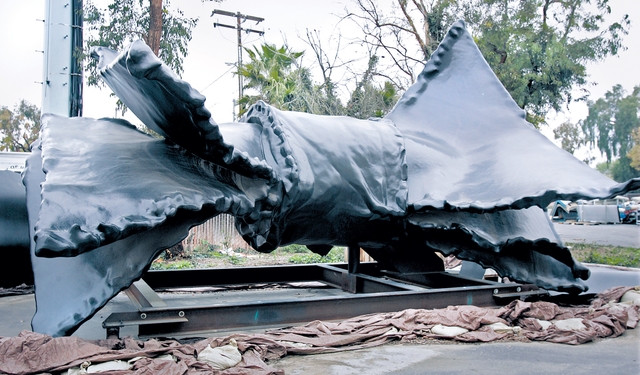 |
A word of caution: the tactile word often has the last laugh. Read this account of Claes Oldenburg and Coosje Van Bruggen's ill-fated Collar and Bow for Frank Gehry's Disney Hall. All the modeling in the world didn't predict the dicey outcome...
Comments (0)
You don't have permission to comment on this page.